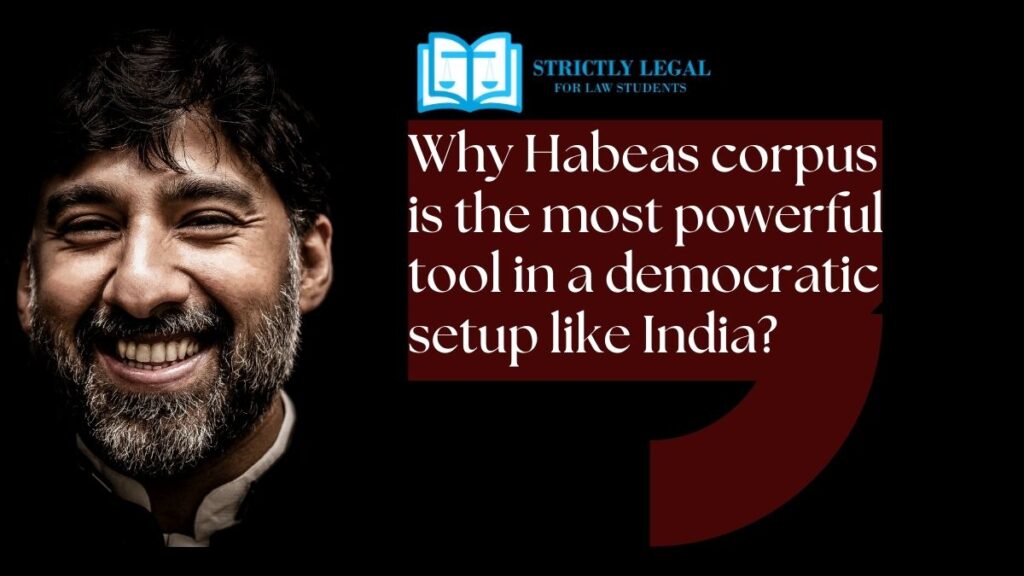The well-known writ of Habeas Corpus is a fundamental right guaranteed by the Constitution of India that protects the citizens against unlawful and indefinite imprisonment. The term “Habeas Corpus” has been derived from a Latin term- “show me the body”. In many countries it is often taken as there is no voice of legal support for detainees or people who are detained in the prison, however, the Constitution of the United States of America sought for making such a provision for the offenders who are sentenced to imprisonment for their legal support and rights, such a right was termed as “Habeas Corpus”. The main motto of this writ is to bring the detainee to the Court of Law and to mention/ state honest and true reasons for their detention.
Habeas Corpus is generally deep-rooted with the English law, and it holds a motive that it will provide quick and fair motive to the detainee who has been unlawfully detained may it be in private or public custody.
Table of Contents
What is a writ?
In simple words, a writ is an official order issued by the court, may it be in the form of a warrant, direction, demand, notice etc. Writs can be issued by the High Court under Article 226 of the Constitution of India and by the Supreme Court under Article 32 of the Constitution of India.
The Constitution of India borrowed the concept of writs from the English Common Law where the writs were used to explain a written command or order from the king. Nonetheless, distinguishing between writs and orders, it can be portrayed that writs are issued to provide extraordinary remedy I.e., where the aggrieved party is asking for an extraordinary remedy that is generally against an administrative action, on the other hand, orders can be passed in any matter. Nonetheless, there are five types of writs specified in the Constitution of India, they are- Habeas Corpus, Mandamus, Prohibition, Certiorari and Quo Warranto.
Understanding Habeas Corpus
As mentioned above, Habeas Corpus is a powerful tool in the fundamental rights that can be availed by any person or a common man who is unlawfully detained by any person or the State. A writ of Habeas Corpus can be issued for safeguarding the liberty of the wrongfully detained person.
Precedents on Habeas Corpus
In State of Bihar v. Kameshwar Prasad Verma, it was held by the Honorable Court of law that, the writ is an order calling the person who is arrested or imprisoned the claimed person for producing the aggrieved party before the court, for knowing the grounds and circumstances for his said detention and if no legal grounds and circumstances are found for his detention then the aggrieved party shall be free from arrest and imprisonment.
In Sapmawia v. Dy. Commissioner, the court finally contended that the main focus and objective of the writ of Habeas Corpus is to safeguard the right of the appellant’s freedom by a crisp and quick judicial review pleading for wrongful detention. This writ, in particular, came before the existence of a statute, hence it is well established in the history of common law.
In a very famous case that is also known as the Habeas Corpus case, of Additional District Magistrate, Jabalpur v. Shiv Kant Shukla, the Honorable Court of law defined what precisely a writ of Habeas Corpus means. Quoting Justice Khanna, “writ of Habeas Corpus is a process of securing the liberty of an aggrieved person by providing an adequate method for immediate relief from wrongful or illegal detention. Whether the person kept in wrongful custody is in prison or under private custody of an individual.”
In Kanu Sanyal v. District Magistrate, Darjeeling, Justice Bhagawati contended that the primary motto of the writ of Habeas Corpus is to safeguard the liberty and freedom of the person who is subjected to illegal and unlawful detention and accord him to enjoy his life and freedom at the fullest. In extension to this motive, the person claimed to be illegally and unlawfully detained is to be produced before the court of law, which is ancillary.
Who may file an application under the Writ of Habeas Corpus?
Any person who has wrongfully and unlawfully been detained may file an application under the Writ of Habeas Corpus which can also be filed by the detainee’s mother, father, wife, brother, sister and also friends on the detainee’s behalf following the rules of different Courts described. In Chiranjit Lal Chowdhury v. Union of India, the Honorable Apex Court asserted that an application under the Writ of Habeas Corpus may be filed by the detainee himself or someone on his behalf provided that the person must not be totally a stranger to the person that is wrongfully detained.
What is the procedure to file an application?
After the acceptance of the application, if the Court of Law is satisfied that there arises a prima facie case for according to the prayer then, the court shall issue a show cause notice (rule nisi) calling the opposite party that had detained the detainee on the specified day to present their side of the case. On that very specified day, the Honorable Court of Law after scrutinizing all the arguments from both the parties will look into the merits and shall pass an order. If the Court views that the detention is unlawful and unjustified then the Court shall order the concerned authority who detained the applicant to release the convict with immediate effect. On the other hand, if the Court of Law views the detention to be justified and lawful, then the show cause notice must be discharged or terminated. In the well known case of State of Maharashtra v. Bahurao Punjabrao Gawande, the Honorable Apex Court contended that the writ of Habeas Corpus can be issued only when the person has been wrongfully and unlawfully detained or arrested but, there are also certain exceptional grounds where the writ of Habeas Corpus may be applied even if the person is not actually detained or arrested.

Law student.
Turning legal insights into engaging narratives.




